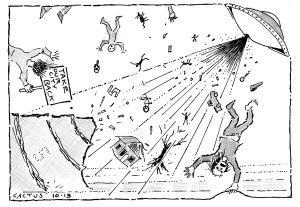By John Mattingly
Until recently, sustainability has been a foreign concept in the American West. Those who initially settled the West encountered a vast resource where everything was there for the taking: a settler could receive allodial title to land by homesteading, ranchers could freely graze the unfenced plains, and miners could dig a hole and patent a claim. Though this is a simplification, it’s fair to suggest that until the early 1970s when the environmental movement got some political traction, the attitude in the American West toward resources was, to put it nicely, driven by the twin principals of private control and maximum utilization.
Settlers endured some hardship and stresses in homesteading and civilizing the West. Few today would have the right stuff to do it. And, drawing loosely on John Locke’s principal that ownership of property was morally tied to the human being who worked that property, settlers of the American West, and their descendants, have successfully promoted rugged individualism, private stewardship, and a hard work ethic to justify, and to some extent glorify, their successes.
But the rugged individuals who settled the West had some help from the federal government in the form of military protection, railroads, reservoirs, highways, logging roads, and finally, rural electrification, without which the settlers might have ended up living in teepees and chasing buffalo (which some people think might have been better in the long run than strip mines, trophy homes and fast food). Whatever one’s disposition might be toward reality, the American West must be characterized in the final analysis as a big experiment in rugged socialism, a partnership between government and hearty individuals that turned a relative wilderness occupied by native peoples into a civilization teeming with a melting pot of cultures and industrial production.
A smaller sub-experiment in rugged socialism is playing out now in the effort of San Luis Valley water users to self-regulate the surface and groundwater systems of the Valley sustainably, even though sustainability, as a legal and/or political word, has only been around for several decades in the American West, and most players are still trying to figure out what it means. Sustainability is an easy word for elected officials to put in a piece of legislation – or judges to put in a ruling – leaving the particulars of administration to an unconducted medley of agencies, lawyers, and stakeholders.
Sustainability sounds simple enough, meaning that some function related to the use of a resource should be sustained according to a baseline level agreed to by the public agencies and private stakeholders. However, agreeing on a baseline, reaching it, and finally enforcing it, is a glacial process. In the meantime, the resource at issue can be frittering away.
A curious thing about sustainability is that it is usually raised as an issue in retrospect, not prospect – that is, sustainability concerns appear in laws and rulings after a resource is seriously diminished, rather than when a resource is first being considered for use.
As mentioned in earlier articles, the water situation (or to some, crisis) in the San Luis Valley has its origins in the 1950s through the 1970s, when less attention was given to matters of sustainability. Just as it’s easy to blame lawyers for stimulating the crisis, it’s equally easy to blame the State of Colorado for lack of foresight when it freely issued well permits and alternate points of diversion in the Valley without serious consideration of the aquifer’s enduring capacity for recharge.
But before we stick a pin in the State, there are a couple of things to consider.
1. Private property rights are dominant (some might say divine) in the U.S., and in the Western U. S., the prevailing presumption is that if a resource exists on private property, it should be used by the owner of that property. That is, if there’s water in the ground, it should be pumped to serve human purposes and enhance the private interests of the property owner.
Property rights are taught in law school as a bundle of sticks. Every time government agencies mandate a new regulation that impacts property rights, the bundle is considered to have lost one of its sticks. Cultural devotion to private property rights is so strong that it’s hard to remove a stick from the bundle, but over time, sticks do get removed. For example, today’s bundle of sticks for a farm property, when compared to, say, the bundle at the time of homesteading, is typically smaller. A property right is subject to taxation, zoning, and a host of common law limitations.
In the case of the San Luis Valley water system, the groundwater users actually added a stick to their bundle. By drilling a well, property owners added a right to pump water on their property and added value to the ground if it subsequently produced high value crops. The fact that the State of Colorado did not recognize the need to register and administer ground water conjunctively with surface water until the 1960s – decades after many wells had been brought into use – appears almost negligent in retrospect. But in fairness, the system of private property ownership has many legal defenses, and offenses.
Government, after all, reflects the will of the majority, or the most powerful. If the will of a powerful majority is to add a stick to the private property bundle, as was the case with groundwater users in the San Luis Valley, it’s hard for government agencies to put up a stop sign and start talking about sustainability when the resource is in a condition of apparent abundance, as it was back in the 1950s through the 1970s.
The State finally put the brakes on well permits in the early 1980s, but by that time there was really no way to know if the number of wells in production would exceed the recharge capacity of the system over the long haul. And groundwater-irrigated farming is a long-haul business requiring capital investment in well drilling, pumps, electrical service and center pivots, together with the machinery and supporting supply chains. Once that capital was invested in the groundwater complex in the Valley, it became a well-heeled, vested capital-cultural interest that was difficult for other vested surface rights to challenge.
2. When it became clear that the groundwater complex was injuring senior surface rights, efforts by the holders of senior surface rights to get the State to take regulatory action were met by a momentum favoring the private ownership interests of groundwater users. Though it is dangerous to generalize here, the momentum of groundwater users had five basic prongs that were problematic to the State Engineer: (a) Obvious as the injury caused by pumping may be in the eye of the beholder, it is difficult to prove in a court of law. Groundwater is like underground weather: hard to predict and full of surprises. (b) Groundwater users grew to be the political majority, leaving surface users the political minority, because groundwater provided the more reliable, season-long water supply than did surface water. (c) Thus, groundwater users had become wealthy, growing high-value crops, while surface users were more from the ranching community, growing grass and pasture, so groundwater users had the resources to employ good legal counsel. (d) The State faced budget cuts, which reduced its capacity to initiate and manage a regime of rules and regulations. (e) And finally, in the agricultural business, processes in motion tend to stay in motion. Banks had loans out to the groundwater complex, and service industries had built up around it, and the entire economy of the Valley had swelled due to the new wealth of the groundwater complex. To suddenly shut it down to restore streams and artesian wells to their historic levels would have had devastating economic consequences.
So, in the San Luis Valley, out-of-priority groundwater pumping has continued long after it was recognized and understood that the pumping was injuring the vested rights of surface users, and that if the pumping continued, could result in near-extinction of the resource. But given the legal and cultural biases favoring private ownership and resource extraction over public responsibility and sustainability, government agencies are arguably between a rock and a hard place when it comes to making effective regulations. Add to this the rollover nature of administrations, with rotating priorities and personnel, and the State Engineer’s office really cannot be given all the blame for the current situation. In the end, it’s difficult to blame any one player for the current condition of the declining San Luis Valley aquifers.
As I have attempted to explain in this series, laudable as it is to try to bring sustainability to the aquifers of the San Luis Valley, the effort faces: (a) a strong cultural bias that favors resource extraction, (b) the divinity of private property rights defended by powerful legal counsel, and (c) water laws that do not favor protection of the commons; it is a trinity of influences that has historically encouraged consumption over conservation, maximum utilization over sustainability, and extinction over reason.
Maybe this time it will be different in the San Luis Valley.



